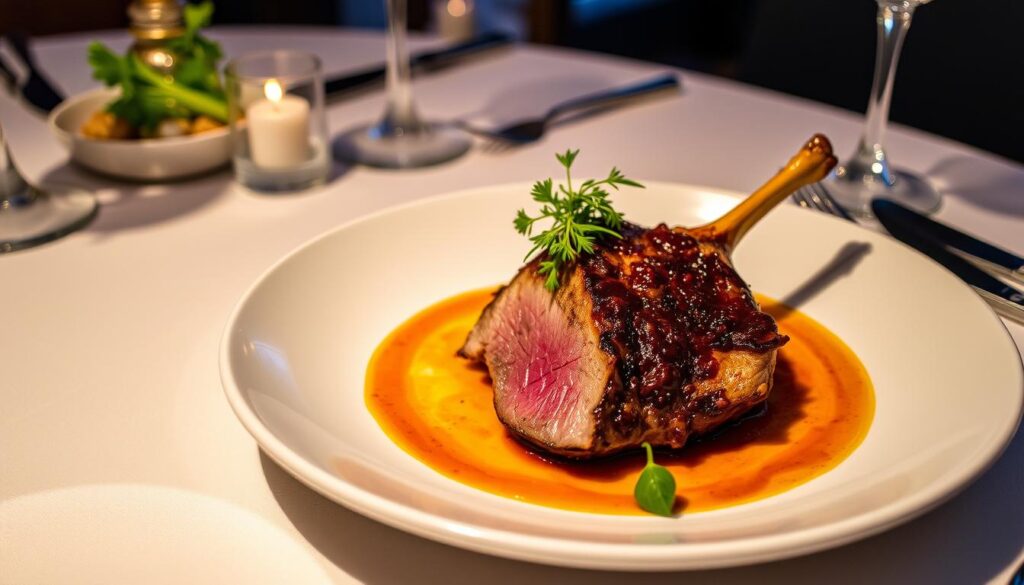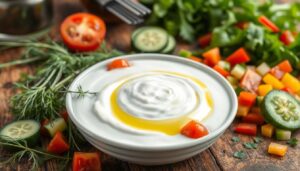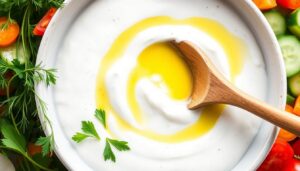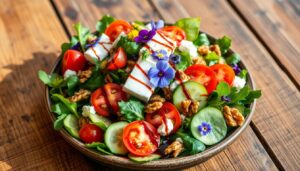I’ve always loved the rich flavors of duck breast. The crispy skin and juicy meat are a treat. But I thought it was only for fancy restaurants. Now, I know you can make it at home too.
In this guide, I’ll teach you how to cook perfect duck breast. You’ll learn how to pick the best duck and prepare it. Plus, you’ll get tips for crispy skin and tender meat. This guide is for both experienced cooks and beginners, and I’ll show you step-by-step how to make it easy and delicious. Whether you’re trying duck for the first time or you’re a seasoned chef, you’ll master the art of cooking duck breast with this foolproof method.
Table of Contents
Understanding Duck Breast: A Premium Cut of Meat
Duck breast is a true culinary gem. It comes from various duck breeds, giving it a rich, succulent flavor. Each breed, like the Pekin and Muscovy, adds its own unique touch.
Different Types of Duck Breeds for Cooking
- Pekin duck: The most widely available and popular duck for cooking, known for its tender, juicy meat and crisp skin.
- Muscovy duck: A larger duck with a more robust flavor, often used in gourmet dishes and charcuterie.
- Moulard duck: A hybrid of Pekin and Muscovy ducks, combining the best qualities of both breeds for a well-balanced taste.
What Makes Duck Breast Special
Duck-breast is special because of its high fat content. This makes it rich and flavorful. When cooked right, the fat melts, making the skin crispy and the inside juicy.
Nutritional Benefits of Duck Breast
Duck-breast is more than just tasty; it’s also nutritious. It has 26 grams of protein in every 4-ounce serving. It’s also packed with vitamins and minerals like B6, iron, and zinc. Even though it has more fat than other poultry, most of it is good for your heart.
“Duck-breast is a versatile and indulgent protein that can elevate any meal to new heights.”
Essential Equipment for Cooking Duck Breast
Cooking duck-breast at home is an art that needs the right tools. You’ll need a heavy-bottomed skillet and an instant-read thermometer. These items help you cook the duck-breast perfectly, making it juicy and crisp-skinned.
- Heavy-bottomed skillet or cast-iron pan: This type of pan is essential for searing the duck-breast and rendering the fat to achieve a crisp skin.
- Sharp knife: A sharp knife is critical for scoring the duck-breast’s skin. This helps the fat render and the skin become delightfully crisp.
- Instant-read thermometer: Monitoring the internal temperature of the duck-breast is essential to ensure it’s cooked to your desired doneness level.
| Equipment | Purpose |
|---|---|
| Heavy-Bottomed Skillet | Searing the duck-breast and rendering the fat for crisp skin |
| Sharp Knife | Scoring the skin to allow the fat to render |
| Instant-Read Thermometer | Monitoring the internal temperature for perfect doneness |
With these essential tools, you’re ready to cook duck-breast. It will have a perfect balance of crisp skin and juicy, flavorful meat.
Selecting and Storing Fresh Duck Breast
For the perfect duck-breast, start with the best ingredients. Choosing the right duck-breast and storing it well is key. Here are the top tips for picking and keeping your duck-breast fresh.
How to Choose Quality Duck Breast
Choosing a great duck-breast means looking at its appearance and feel. It should have a deep, rich color without any spots or blemishes. The skin should be soft and even, with a thin layer of fat.
Gently press the meat. It should feel firm but also plump. This shows it’s fresh and tender.
Proper Storage Guidelines
- Wrap the duck-breast tightly in plastic wrap or store it in an airtight container to prevent air exposure and retain moisture.
- Keep the duck-breast refrigerated at 40°F (4°C) or below until ready to use.
- Consume the duck-breast within 3-4 days of purchase for optimal freshness.
Shelf Life and Freezing Tips
If you need to store the duck breast for longer, freezing is a good option. Frozen duck-breast can last up to 6 months. Wrap it tightly in plastic wrap or freezer paper, then put it in an airtight container or freezer bag.
When you’re ready to cook, thaw the duck-breast in the fridge overnight.
By following these tips for selecting and storing duck-breast, you’ll make delicious dishes. These dishes will show off the best of this premium meat.
Preparing Your Duck Breast for Cooking
Preparing duck breast starts with trimming excess fat, but be careful not to remove too much. The fat is what makes the skin crispy and delicious. Once you’ve trimmed, use paper towels to thoroughly dry the skin. This step is crucial because moisture will prevent the skin from crisping up during searing. With the fat trimmed and skin dried, you’re ready to start cooking and achieve that perfect crispy texture on your duck breast.
Now, it’s time to season your duck-breast. Begin by sprinkling salt and black pepper all over the skin. You can also add garlic powder, onion powder, or paprika for extra flavor. Rub the seasoning into the skin to make sure it’s evenly spread.
- Trim excess fat from the duck-breast, leaving just enough to render down and create a crispy skin.
- Pat the skin dry with paper towels to remove any excess moisture.
- Season the duck-breast generously with a blend of salt, black pepper, and other aromatic spices.
- Rub the seasoning evenly into the skin to ensure maximum flavor penetration.
By following these steps, you’ll get a perfectly cooked duck-breast. It will have rich meat and crispy skin. Now, you’re ready to cook it. You’ll learn how to get that golden-brown sear and juicy inside.
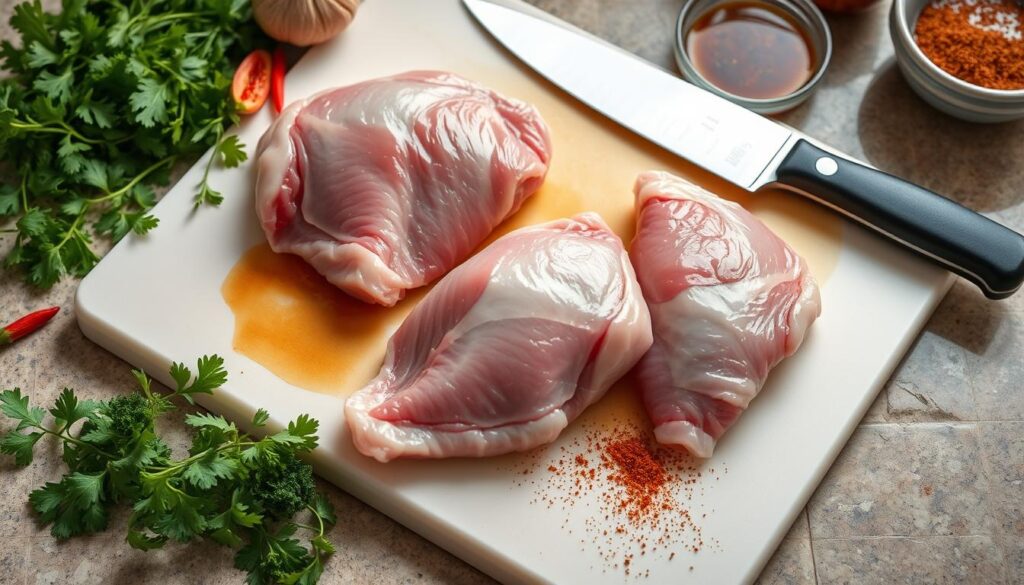
The Perfect Duck Breast Temperature Guide
Understanding the ideal internal temperature is key to cooking the perfect duck breast. The right temperature ensures a juicy, tender result. It also lets you choose your desired doneness, from rare to well-done. Let’s explore the temperature recommendations for duck-breast and how to use a meat thermometer for perfect results every time.
Internal Temperature Recommendations
The recommended internal temperature for duck-breast varies based on personal preference. Here are the generally accepted guidelines:
- Rare: 120-125°F (49-52°C)
- Medium-rare: 130-135°F (54-57°C)
- Medium: 140-145°F (60-63°C)
- Medium-well: 150-155°F (66-68°C)
- Well-done: 160°F (71°C) and above
Temperature Based on Doneness Levels
To get your desired doneness, use a reliable meat thermometer. It helps monitor the internal duck breast temp during cooking. Here’s a quick guide:
| Doneness Level | Internal Temperature |
|---|---|
| Rare | 120-125°F (49-52°C) |
| Medium-rare | 130-135°F (54-57°C) |
| Medium | 140-145°F (60-63°C) |
| Medium-well | 150-155°F (66-68°C) |
| Well-done | 160°F (71°C) and above |
Exactly! The key to perfect duck breast is knowing your preferences and adjusting the cooking temperature accordingly. While the guidelines provide a great starting point, feel free to tailor them to achieve the exact texture and flavor you desire. The beauty of cooking duck breast is that it can be customized to your liking—whether that’s a juicy, tender medium-rare or a more well-done cut. Using a meat thermometer and paying attention to the doneness will ensure your duck breast turns out just right every time.
Scoring the Skin: Technique and Tips
Scoring duck-breast skin is key to getting that crispy, golden-brown outside. This simple step helps the fat render evenly. It makes the meat juicy and tender.
To score duck breast skin like a pro, follow these step-by-step tips:
- Identify the Grain: Look closely at the duck-breast skin to find the muscle fibers’ direction. This helps you score it right.
- Score Perpendicular to the Grain: Use a sharp knife to make shallow cuts across the skin. Cut at a 90-degree angle to the grain. Try to score about 1/8 to 1/4 inch deep, without cutting through to the meat.
- Maintain a Consistent Spacing: Keep the scoring lines about 1/2 to 1 inch apart. This ensures the fat renders evenly during cooking.
- Repeat in the Opposite Direction: Score the skin again in the opposite direction. This creates a crosshatch pattern for extra crispiness.
- Thoroughly Dry the Skin: Dry the duck-breast with paper towels before scoring. This makes the knife move smoothly and prevents tears.
Proper scoring is the secret to crackly, crisp duck breast skin. Master this step, and you’ll cook perfect duck-breast every time.
The Essential Pan-Searing Method
Pan-searing is essential for achieving that crispy, golden-brown skin and juicy interior in duck breast. Here’s a step-by-step guide to master this technique, along with common mistakes to avoid.
Step-by-Step Pan Searing Process
To pan-sear your duck-breast perfectly, just follow these steps:
- Pat the duck-breast dry with paper towels to remove any excess moisture.
- Season the duck-breast generously with salt and pepper, or your preferred seasoning blend.
- Preheat a heavy-duty, oven-safe skillet over medium-high heat. Once the pan is hot, add a small amount of high-smoke-point oil, such as avocado or grapeseed oil.
- Carefully place the duck-breast, skin-side down, in the hot pan. Apply gentle pressure to ensure even contact with the pan.
- Sear the duck-breast for 4-6 minutes, or until the skin is crisp and golden-brown.
- Flip the duck-breast and sear the other side for an additional 2-3 minutes, or until it reaches your desired doneness.
Common Searing Mistakes to Avoid
While pan-searing duck breast seems easy, there are mistakes to watch out for:
- Overcrowding the pan: Make sure to sear the duck breast in a single layer, with enough space between the pieces to ensure even browning.
- Searing at too high of a temperature: This can lead to a burnt, bitter crust and an undercooked interior. Maintain a consistent medium-high heat for optimal results.
- Skipping the resting period: Allow the seared duck-breast to rest for 5-10 minutes before slicing into it. This important step helps the juices redistribute, resulting in a more tender and flavorful final dish.
By following these guidelines and avoiding common pitfalls, you’ll be well on your way to mastering how to cook duck breast and creating restaurant-quality results at home. With the right preparation, temperature control, and searing technique, you’ll achieve a beautifully crispy skin and tender, juicy meat every time. Enjoy experimenting with different seasonings, sauces, and sides to elevate your duck breast dish to new heights! Whether you’re trying out a rich berry reduction or a tangy citrus glaze, the possibilities are endless for customizing your duck to match your taste preferences.
Achieving Crispy Skin and Juicy Meat
The secret to a perfect duck-breast is finding the right mix of crispy skin and juicy meat. This mix of textures makes a duck-breast dish truly special. Knowing how to control temperature and cooking time is key to getting this perfect mix.
To bring out the best in your duck breast, start by searing the skin over medium-high heat. This step is essential for getting that crispy texture. The fat will melt, and the skin will turn golden brown.
- Keep the duck cooking temp between 400-450°F (200-230°C) while searing.
- Cook for 4-6 minutes on each side to get the skin crispy and the meat juicy.
- Don’t overcrowd the pan, as it can make the skin soft instead of crispy.
After the skin is crispy, flip the duck breast and cook until it’s done to your liking. The duck cooking temp for the inside should be between 125-135°F (52-57°C). This will give you a pink, medium-rare center.
| Doneness Level | Internal Temperature |
|---|---|
| Rare | 125°F (52°C) |
| Medium-Rare | 130°F (54°C) |
| Medium | 135°F (57°C) |
| Medium-Well | 140°F (60°C) |
| Well-Done | 160°F (71°C) |
With practice in temperature control and cooking time, you’ll get perfect duck-breast every time.
Resting and Slicing Your Duck Breast
After searing your duck breast, it’s crucial to let it rest for about 5-10 minutes. This allows the juices to redistribute, ensuring the meat remains tender and juicy. When slicing, make sure to cut against the grain to ensure the meat stays tender and looks beautiful on the plate. A sharp knife will help you achieve clean, even slices that showcase the perfect sear and juicy interior. This final touch will elevate your duck breast, making it restaurant-worthy at home!
Proper Resting Time
Let your duck-breast rest for 5-10 minutes after cooking. This helps the juices stay inside. It makes the meat tender and juicy.
Slicing Techniques for Presentation
- Slice the duck-breast against the grain for thin, even slices.
- Use a sharp knife for clean, precise cuts.
- Arrange the slices in an overlapping pattern on the plate.
By following these steps, you’ll serve a dish that impresses everyone. Your duck-breast will look and taste amazing. With practice, you’ll wow your guests with your duck-breast skills.
Classic Duck Breast Sauce Pairings
When it comes to duck breast recipes and how to cook duck, the right sauce can make all the difference. It can turn a simple dish into a feast for the senses. Let’s explore some classic pairings that will make your duck-breast shine.
Fruit-based sauces are a timeless choice when it comes to pairing with duck. A cherry or orange sauce adds a sweet and tangy touch that complements the rich flavor of the duck. For something a bit more adventurous, consider trying a pomegranate reduction or a blackberry gastrique. These fruit-based sauces bring a burst of vibrant flavor that cuts through the richness of the duck, elevating the dish and adding a modern twist to your meal.
Asian-inspired sauces also pair beautifully with duck breast recipes. A hoisin or soy-based glaze brings a deep umami flavor. A spicy plum sauce or a ginger-garlic sauce adds a spicy kick and a complex taste.
| Sauce | Flavor Profile | Complementary Dishes |
|---|---|---|
| Cherry Sauce | Sweet, tart, and fruity | Pan-seared duck-breast, roasted duck |
| Orange Sauce | Citrusy, slightly sweet | Grilled duck-breast, duck confit |
| Pomegranate Reduction | Tart, tangy, and slightly sweet | Seared duck-breast, duck-breast salad |
| Hoisin Sauce | Savory, sweet, and umami | Roasted duck, duck-breast rolls |
| Spicy Plum Sauce | Sweet, sour, and spicy | Pan-seared duck-breast, duck-breast stir-fry |
Try these classic sauce pairings to take your duck breast recipes to the next level. The right sauce can turn a simple dish into a work of art. So, get creative and enjoy the journey of how to cook duck!
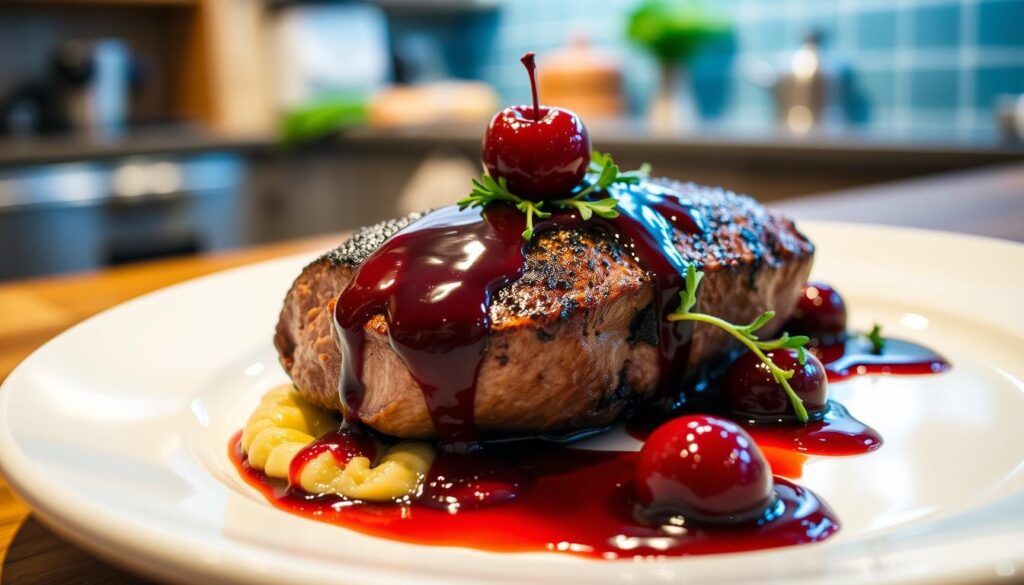
Wine and Side Dish Recommendations
Pairing your expertly cooked duck breast with the right wine and side dishes can truly elevate your meal. For a wine pairing, consider a red wine like Pinot Noir or Merlot, which complements the rich, tender flavors of duck without overpowering it. If you prefer white wine, try a full-bodied Chardonnay, which works well with the duck’s crispy skin and savory notes.
As for side dishes, roasted root vegetables like carrots, parsnips, or sweet potatoes make for a hearty, comforting addition. A light, refreshing salad with citrus or apple slices can provide a nice contrast to the richness of the duck. You can also serve the duck with a savory grain like quinoa or wild rice to round out the meal.
Together, these pairings will enhance the duck’s flavor and create a well-balanced, delicious dining experience.
Best Wine Pairings
The rich and savory nature of duck breast pairs exceptionally well with a variety of wines. For a classic pairing, consider a bold and fruity red wine like Pinot Noir or Merlot. These wines’ acidity and tannins can balance the duck’s natural fattiness, while complementing its deep flavors. If you prefer a white wine, a full-bodied Chardonnay can be a great choice, offering a buttery texture that enhances the crispy skin and savory richness of the duck.
Additionally, for those looking for a unique twist, a fruity yet spicy Zinfandel or a light, bright Beaujolais can provide an unexpected, delicious contrast to the richness of the duck.
Alternately, a medium-bodied Cabernet Sauvignon or Shiraz can also complement the duck breast beautifully.
If you prefer white wine, an off-dry Riesling or a crisp Sauvignon Blanc can provide a refreshing contrast to the duck. The wine’s acidity and subtle sweetness can help cut through the richness of the duck-breast.
Complementary Side Dishes
When it comes to side dishes, the key is to choose options that will complement the flavors of the duck-breast without overpowering it. Consider roasted vegetables, such as Brussels sprouts, carrots, or potatoes, which can add a delightful contrast to the dish.
- Roasted root vegetables (carrots, parsnips, sweet potatoes)
- Sautéed greens (kale, spinach, Swiss chard)
- Caramelized onions or shallots
- Creamy mashed potatoes
- Fruity accompaniments (apple compote, cherry relish, orange segments)
By pairing your perfectly cooked duck breast with the right wine and side dishes, you can create a harmonious and memorable dining experience. This showcases the rich, savory flavors of this premium cut of meat.
Troubleshooting Common Duck Breast Problems
Cooking how to cook duck breast at home can be rewarding but comes with challenges. You might face issues like undercooked meat, rubbery skin, or too much fat. Don’t worry, we’ve got solutions and tips to help you cook great duck breast temp dishes every time.
Undercooked Duck Breast
If your duck-breast is not cooked right, it might look pink or raw inside. To fix this, keep an eye on the internal temperature. Aim for at least 135°F (57°C) for medium-rare. Using a meat thermometer can help you track the duck breast temp accurately.
Rubbery Skin
Getting crispy, golden-brown skin is key for a great how to cook duck breast. If the skin is rubbery, try scoring it deeper before cooking. Also, make sure your pan is hot and you’re not cooking too much meat at once.
Excessively Fatty Duck Breast
Duck-breast is rich and fatty, but too much fat can be a problem. Trimming excess fat before cooking can help. Also, watch your cooking time and temperature to avoid a greasy texture.
| Common Duck Breast Problems | Possible Causes | Solutions |
|---|---|---|
| Undercooked Duck-Breast | – Insufficient cooking time – Inaccurate temperature monitoring | – Use a meat thermometer to ensure a minimum internal temperature of 135°F (57°C) – Adjust cooking time as needed |
| Rubbery Skin | – Insufficient scoring of the skin – Overcrowding the pan | – Score the skin more deeply before cooking – Ensure the pan is hot enough and not overcrowded |
| Excessively Fatty Duck-Breast | – Overcooking the meat – Insufficient fat trimming | – Trim some of the excess fat before cooking – Monitor the cooking time and temperature to prevent overcooking |
By knowing these common how to cook duck breast issues and using the right fixes, you’ll get better at cooking. You’ll learn to make duck breast temp dishes that are juicy, flavorful, and perfectly textured at home.
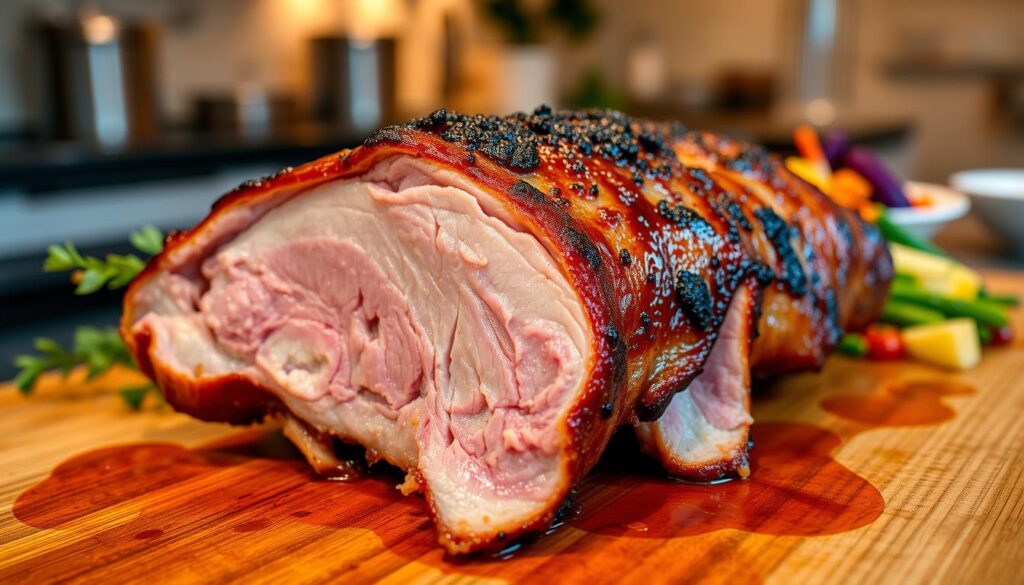
Creative Duck Breast Recipes and Variations
Take your duck breast cooking to the next level with new recipes. Try different ways to cook this special meat. Explore dishes from around the world and mix flavors in exciting ways.
Be bold and try a Duck Breast Ramen. It’s a perfect mix of savory duck and tasty noodles in a rich broth. Or, go for a Duck Breast Gyro with grilled pita, tzatziki, and a cool cucumber salad for a Mediterranean vibe.
For something sweet and savory, make a Duck Breast with Cherry Compote. It’s a great way to enjoy the juicy duck with a tangy cherry sauce. Or, try Duck Breast Tacos with crunchy slaw and zesty lime crema for a Mexican twist.
Exploring new duck breast recipes means being open to new tastes. Don’t hesitate to try something new. These variations will impress your guests or treat you to a special meal.
Conclusion
Congratulations! You now know how to cook perfect duck breast at home. You’ve learned about the meat’s unique qualities, the right tools, and key techniques. This will help you make duck breasts that are juicy, crispy, and delicious.
For top-notch duck breast, focus on the details. Choose the right duck breed and control the cooking temperature. Also, let the meat rest properly. With these tips, you can try new sauces and sides to make your own special duck dishes.
There’s nothing better than enjoying a duck breast you cooked yourself. It’s a gourmet treat that’s unmatched. Keep practicing and you’ll get better and more creative with cooking duck breast. Bon appétit! Reviewed by Koujil Amine, founder of YummyWhirl, and generated by Emma Chef.
